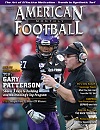Article CategoriesAFM Magazine
|
Your Take: Turn Back the Clock For Safetyby: Joe HadarVice President, Hadar Athletic Company © More from this issue The recently completed football season will go down in history as the year of the concussion. Not because the game fundamentally changed, but improvements in head injury detection have forced a closer examination of the subject at all levels of the game. The football community is no longer taking a “head in the sand” approach to a problem that has existed for a long time but only now is beginning to be understood. In the future, head injuries in football will decline. The solution will involve technology, improved equipment, improved medical attention, coaching and player attitude changes. But, more than anything else, it will hinge on rule changes. Rule changes in football are the fastest way to reduce concussions. To improve the game and reduce head injuries, perhaps a return to some form of sin....The full article can only be seen by subscribers.
|
|
|||||||
| HOME |
MAGAZINE |
SUBSCRIBE | ONLINE COLUMNISTS | COACHING VIDEOS |
Copyright 2025, AmericanFootballMonthly.com
All Rights Reserved





